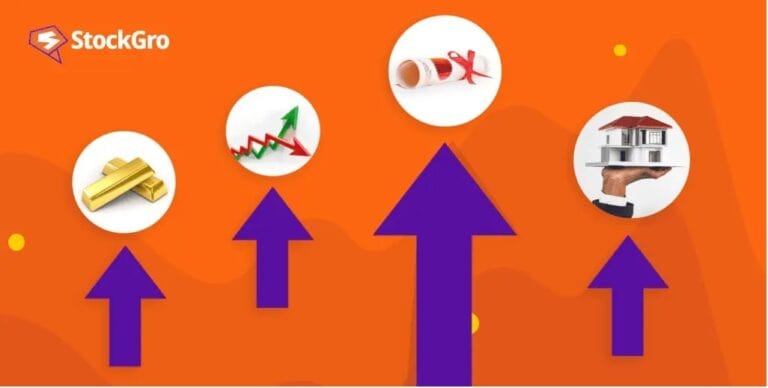
In financial markets, the capital market line (CML) stands out as a crucial concept. It is a line that illustrates the correlation between risk and return for efficient portfolios. This theoretical construct uses a risk-free rate plus market risk premium hence integrating capital asset pricing model to come up with an optimal portfolio construction.
It is therefore not merely a graph but rather an equilibrium point where any investor can sit regardless of their risk appetite.
This is why we will go deeper into understanding its formula and its implications for portfolio optimisation.
What is the capital market line?
The capital market line (CML) is a linear correlation that illustrates the expected returns of various portfolios against their associated risks. It operates under the assumption that all investors are rational and aim to maximise their returns.
As a visual tool, the CML maps an investment’s projected return against its respective risk, following the principles of the Capital Asset Pricing Model (CAPM). According to CAPM, the expected return of a security can be calculated by adding a risk premium to the risk-free rate.
The CML serves as a guide to pinpoint the optimal portfolio, which is defined as the one that provides the highest anticipated return for a specified level of risk.
CML helps investors see where an investment should lie in terms of potential return and its associated level of risk, allowing them to select the optimal portfolio that results in maximum expected returns for an acceptable degree or measure of risk.
The capital market line (CML) pinpoints the best portfolio, defined as the one that yields the maximum expected return for a certain risk level.
In other words, investors should aim to find the portfolio on the CML that optimises expected returns, given a particular level of risk. However, it is essential to recognise that the CML is a theoretical construct and may not precisely mirror real-world market conditions.
Additionally, the CML assumes that all investors act rationally and aim to maximise their returns, which might not always hold true in practice. Although the capital market line (CML) is a useful instrument, it is essential to consider other elements when making investment choices.
Capital market line formula
The capital market line calculation can ease the investment process and projections for the investors. It can be done with the help of a simple formula that measures returns against the risk presented by standard deviation.
Capital line formula
The formula for CML is as follows:
It can be further simplified with the help of a hypothetical example.
Suppose, Ms K is willing to calculate CML. The market risk-free returns are 8%, and the market returns are 12%. However, she invests in equities. So, the standard deviation of her portfolio returns is 20%, and the standard deviation from market returns is 25%.
Therefore, her capital market line would be:
Rp = Rf + [((Rt-Rf)/σt)*σp]
Rp = 0.08 + [((0.12-0.08)/0.25)*0.20]
Rp = 0.112
Rp = 11.2%
Thus by inputting the values into the equation, investors can determine the anticipated return for any given risk level.
Must read: Risk Free Rate
What does the CML tell you?
The CML considers both the risk-free rate and the market portfolio risk, making it superior to the Efficiency Frontier, which only accounts for risky assets. The slope of the CML is known as the market portfolio’s Sharpe ratio, a financial metric used to calculate the portfolio’s return adjusted for risk.
On a graph, the intersection of the CML and the Efficient Frontier denotes the most efficient portfolio and is referred to as the point of tangency.
As you ascend the CML, both the portfolio’s risk and expected return increase. Conversely, descending the CML leads to a reduction in both risk and expected return.
Theoretically, portfolios that align with the capital market line (CML) optimise the balance between risk and return, thus enhancing performance.
As a rule of thumb, assets should be purchased if the Sharpe ratio is above the CML and sold if their Sharpe ratio falls below the CML.
Also read: Stock Market Risk
CML vs SML
The capital market line and the security market line are two different concepts. Here are a few differences:
| Comparison Attribute | Capital Market Line (CML) | Security Market Line (SML) |
| Meaning | CML shows the rates of return for a specific portfolio | SML relates individual assets to the market’s risk and return. |
| Risk-return trade-off | Evaluates for a single asset | Constructs optimal investment portfolios with different risk levels. |
| Risk Measures | The standard deviation of returns (total risk) | Systematic risk (beta) |
Must read: Risk adjusted return on capital
How to calculate Capital Market Line?
The Capital Market Line (CML) represents the risk-return relationship for efficient portfolios that combine a risk-free asset with a market portfolio. The formula for calculating the expected return on the CML is:
E(Rp) = Rf + [(E(Rm) – Rf) / σm] × σp
Where:
- E(Rp) = Expected return of the portfolio
- Rf = Risk-free rate
- E(Rm) = Expected return of the market
- σm = Standard deviation of the market
- σp = Standard deviation of the portfolio
This formula helps investors evaluate whether they’re being adequately compensated for the level of risk they’re taking relative to the market.
Bottomline
To sum up, the capital market line (CML) serves as a potent instrument in the financial sphere, offering a theoretical framework to comprehend the correlation between risk and return and assisting in the formation of ideal portfolios.
One must bear in mind that the CML is a model, and actual market conditions may not always mirror this model. Nevertheless, the CML lays a solid foundation for analysing investments. Yet, investors must consider additional factors and the realities of the market when making investment choices.
The Capital Market Line (CML) is a crucial concept in modern portfolio theory, representing the risk-return trade-off of efficient portfolios. To explore this and other advanced investment concepts in a simplified way, download the StockGro app your guide to smarter, more informed trading.

